Did You Know?: Off-season football field care
February 13, 2013
 |
|
Off-season care of the field at Ross-Ade Stadium
becomes paramount at the end of every regular season, says Al Capitos,
superintendent of turf and maintenance for Intercollegiate Athletics. |
Preparing the football field at Ross-Ade Stadium for the annual spring scrimmage and the following season begins as soon as the previous season's final game ends.
Off-season care of the field, which must be ready for the spring scrimmage each April, becomes paramount at the end of every regular season, says Al Capitos, superintendent of turf and maintenance for Intercollegiate Athletics.
"Unfortunately, we can't just have the last football game, walk away and expect the field to be ready come spring," Capitos says. "There are a lot of maintenance and preventive measures we have to take to make sure the grass on the field will be ready."
Immediately following the final regular season game, staff members follow standard post-game protocol related to the field's care, including picking up trash and debris, checking for damage, filling in divots and rolling the turf.
When that's done, staff members apply fungicides to help ward off winter diseases such as pink snow mold that might infect the field's ryegrass, a turf type that is used to over-seed the Bermuda grass. The Bermuda grass enters dormancy during the winter; earlier in the fall, staff members introduce the ryegrass and the team plays on it during the spring game.
After the spring game, staff members use a selective herbicide to remove the ryegrass and begin cultivating the underlying Bermuda grass, which is thicker and better suited to long-term play.
Dangers to Bermuda grass during the winter months include spring dead spot, Capitos says. Because Bermuda grass is native to warmer climates, prolonged freezes also can kill it.
To prevent frosts from harming the grass, just before winter begins staff members cover the field with three blankets fashioned from a nonwoven geotextile. That special material allows moisture to reach the plants, but it protects them from any winter snow or frost.
Once the blankets are in place, staff members cover the seams with sand to prevent wind from moving them. Throughout the winter, staff members check under the blankets for excessive water or frost. Maintaining the field in the late fall and throughout the winter is a long, arduous process, Capitos says.
"It's really about the weather -- we constantly monitor weather conditions to try to anticipate any grass losses we might suffer," Capitos says. "Exactly what is going on under those blankets is a constant concern all winter long."
Writer: Amanda Hamon, 49-61325, ahamon@purdue.edu
